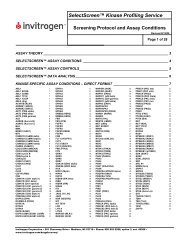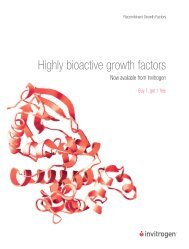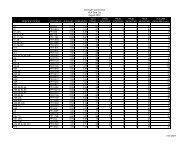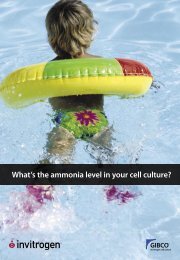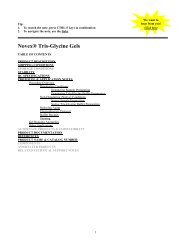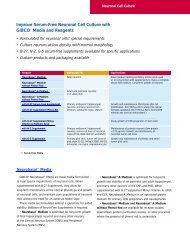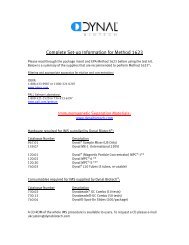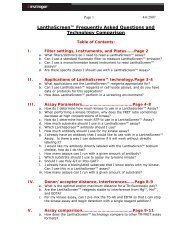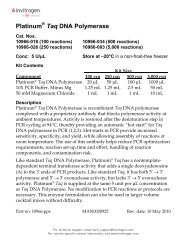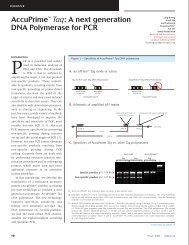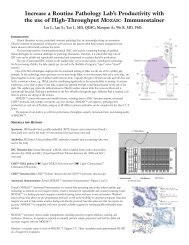TRIzol Reagent - Invitrogen
TRIzol Reagent - Invitrogen
TRIzol Reagent - Invitrogen
Create successful ePaper yourself
Turn your PDF publications into a flip-book with our unique Google optimized e-Paper software.
Large pellet after initial ethanol precipitation<br />
(back to Table of Contents)<br />
(back to Protocol and Application Notes)<br />
(back to DNA Isolation with <strong>TRIzol</strong>)<br />
This pellet may contain connective tissue and protein, in addition to the DNA. If the pellet is reddish (it should be white), this<br />
indicates that there is unhomogenized tissue present. Proteins can leach out and cause a lower OD ratio (NaOH will solubilize<br />
protein). Centrifuging the sample at high speed once it is resuspended in the NaOH will pellet this tissue and protein.<br />
Aqueous layer appeared after addition of 100% ethanol<br />
(back to Table of Contents)<br />
(back to Protocol and Application Notes)<br />
(back to DNA Isolation with <strong>TRIzol</strong>)<br />
There are several possible reasons for this:<br />
If the aqueous phase was removed completely and the ethanol was added to the samples, it will remain on top of the<br />
<strong>TRIzol</strong> due to ethanol’s lower density. If the samples were centrifuged without mixing the two liquids, the ethanol will<br />
remain on top of the <strong>TRIzol</strong> after centrifugation, the DNA will remain at the interface and the <strong>TRIzol</strong> will be localized to<br />
the red bottom organic fraction. If the ethanol was not mixed properly, proceed with mixing the samples, then centrifuge<br />
and proceed with step 1 of the DNA isolation protocol.<br />
If 70% ethanol was added accidentally, it may be possible to get a small volume of water on top of the organic fraction.<br />
The phase separation was not complete during the RNA isolation step. This can occur because the chloroform or BCP<br />
was not adequately mixed, the samples were not centrifuged at the proper g-force, for the required period of time or at the<br />
correct temperature. The net result is that significantly less than 600 µl of the RNA aqueous phase will be recovered from<br />
the sample. Phase separation problems usually occur when the chloroform or BCP are mixed by vortexing. Due to the<br />
large difference in density between <strong>TRIzol</strong> and the organic, the solutions are never mixed completely and only a portion<br />
of the aqueous phase will be recovered. When the ethanol is added and the samples are remixed sufficiently, the phase<br />
separation will go to completion and water could appear on top of the sample.<br />
Protein Isolation with <strong>TRIzol</strong><br />
(back to Table of Contents)<br />
(back to Protocol and Application Notes)<br />
Detailed Protocol Steps for Protein Isolation with <strong>TRIzol</strong><br />
Protein Precipitation<br />
Protein Wash<br />
Redissolving the Protein Pellet<br />
Additional Notes for Protein Isolation with <strong>TRIzol</strong><br />
Recovering phosphorylated proteins<br />
Membrane proteins<br />
Analysis of proteins before precipitation<br />
Interference of SDS with protein quantitation<br />
Analyzing proteins by RIA<br />
Precipitation of SDS during dialysis<br />
Quick overview of Protocol<br />
1. Add isopropanol to the phenol/ethanol supernatant to precipitate the proteins. Incubate at room temperature and spin.<br />
2. Wash pellet with guanidine/ethnaol solution. Spin.<br />
3. Solubilize the protein pellet.<br />
Detailed steps for Protein Isolation with <strong>TRIzol</strong><br />
Protein Precipitation<br />
(back to Table of Contents)<br />
20



